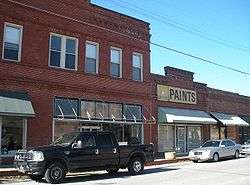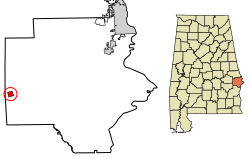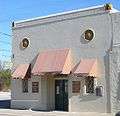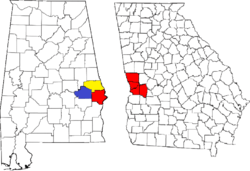Hurtsboro, Alabama
Hurtsboro is a town in Russell County, Alabama, United States. At the 2010 census the population was 553, down from 592 in 2000. It was founded in 1857 as Hurtsville and named for Joel Hurt, Sr. (whose son, Joel Hurt, was an important developer of Atlanta, Georgia). A railroad spur from Columbus, Georgia was completed the next year. It was incorporated in 1872 and in 1883 the town name was changed to Hurtsboro.
Hurtsboro, Alabama | |
|---|---|
Town | |
 | |
 Location of Hurtsboro in Russell County, Alabama. | |
| Coordinates: 32°14′24″N 85°24′55″W | |
| Country | United States |
| State | Alabama |
| County | Russell |
| Area | |
| • Total | 1.03 sq mi (2.67 km2) |
| • Land | 1.03 sq mi (2.67 km2) |
| • Water | 0.00 sq mi (0.00 km2) |
| Elevation | 351 ft (107 m) |
| Population (2010) | |
| • Total | 553 |
| • Estimate (2019)[2] | 589 |
| • Density | 570.18/sq mi (220.22/km2) |
| Time zone | UTC-6 (Central (CST)) |
| • Summer (DST) | UTC-5 (CDT) |
| ZIP code | 36860 |
| Area code(s) | 334 |
| FIPS code | 01-37096 |
| GNIS feature ID | 0151840 |
| Website | www |
The town is part of the Columbus, Georgia-Alabama Metropolitan Statistical Area.
History
In 1920 there was a standoff and siege at a house in Hurtsboro, Alabama, called the Hurtsboro race riot. The newspaper, The Topeka State Journal called the incident a "New Race War." [3]
Geography
Hurtsboro is located at 32°14′24″N 85°24′55″W (32.240102, −85.415377).[4]
According to the U.S. Census Bureau, the town has a total area of 1.0 square mile (2.6 km2), all land.
Demographics
| Historical population | |||
|---|---|---|---|
| Census | Pop. | %± | |
| 1890 | 433 | — | |
| 1900 | 407 | −6.0% | |
| 1910 | 764 | 87.7% | |
| 1920 | 868 | 13.6% | |
| 1930 | 884 | 1.8% | |
| 1940 | 894 | 1.1% | |
| 1950 | 920 | 2.9% | |
| 1960 | 1,056 | 14.8% | |
| 1970 | 937 | −11.3% | |
| 1980 | 752 | −19.7% | |
| 1990 | 707 | −6.0% | |
| 2000 | 592 | −16.3% | |
| 2010 | 553 | −6.6% | |
| Est. 2019 | 589 | [2] | 6.5% |
| U.S. Decennial Census[5] 2013 Estimate[6] | |||
As of the census[7] of 2000, there were 592 people, 283 households, and 161 families residing in the town. The population density was 573.7 people per square mile (221.9/km2). There were 342 housing units at an average density of 331.5 per square mile (128.2/km2). The racial makeup of the town was 70.27% Black or African American, 29.39% White, and 0.34% from two or more races. 0.17% of the population were Hispanic or Latino of any race.
There were 283 households, out of which 25.1% had children under the age of 18 living with them, 31.1% were married couples living together, 23.3% had a female householder with no husband present, and 43.1% were non-families. 41.7% of all households were made up of individuals, and 18.7% had someone living alone who was 65 years of age or older. The average household size was 2.09 and the average family size was 2.86.
In the town, the population was spread out, with 24.2% under the age of 18, 7.1% from 18 to 24, 25.7% from 25 to 44, 22.8% from 45 to 64, and 20.3% who were 65 years of age or older. The median age was 40 years. For every 100 females, there were 93.5 males. For every 100 females age 18 and over, there were 82.5 males.
The median income for a household in the town was $16,691, and the median income for a family was $25,000. Males had a median income of $26,979 versus $19,821 for females. The per capita income for the town was $16,908. About 28.4% of families and 32.8% of the population were below the poverty line, including 46.3% of those under age 18 and 28.5% of those age 65 or over.
Gallery
 Town welcome sign
Town welcome sign- Hurtsboro City Hall
- Hurtsboro Post Office (ZIP code: 36860)
- Hurtsboro Police Department
 Hurtsboro Library
Hurtsboro Library The Hurtsboro Historic District was added to the National Register of Historic Places on October 19, 2009
The Hurtsboro Historic District was added to the National Register of Historic Places on October 19, 2009- The Joel Hurt House was built in 1857. The home was added to the National Register of Historic Places on August 11, 2005.
 The City Grill Café is a local landmark.
The City Grill Café is a local landmark.- Pat H. Perry Hardware
 Some of the older buildings on Main Street.
Some of the older buildings on Main Street.
References
- "2019 U.S. Gazetteer Files". United States Census Bureau. Retrieved June 29, 2020.
- "Population and Housing Unit Estimates". United States Census Bureau. May 24, 2020. Retrieved May 27, 2020.
- The Topeka State Journal, December 30, 1920, p. 1.
- "US Gazetteer files: 2010, 2000, and 1990". United States Census Bureau. February 12, 2011. Retrieved April 23, 2011.
- "U.S. Decennial Census". Census.gov. Retrieved June 6, 2013.
- "Annual Estimates of the Resident Population: April 1, 2010 to July 1, 2013". Archived from the original on May 22, 2014. Retrieved June 3, 2014.
- "U.S. Census website". United States Census Bureau. Retrieved January 31, 2008.
- "New Race War Is On". The Topeka State Journal. Topeka, Shawnee, Kansas: F.P. MacLennan. December 30, 1920. pp. 1–8. ISSN 2377-7117. OCLC 9124974. Retrieved December 30, 2019.

